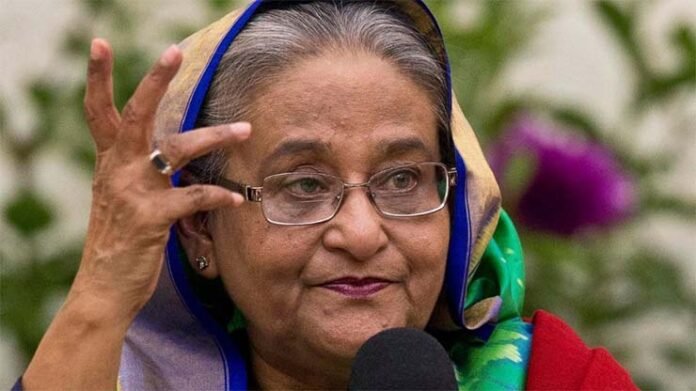Bangladesh’s erstwhile Prime Minister Sheikh Hasina, who served as Bangladesh’s PM consecutively since January 2009 and is the world’s longest-serving Muslim woman leader, saw her tenure come to an end amid the current turmoil, in her country. In a televised address, Army Chief Waker-uz-Zaman confirmed that the military has taken control of Dhaka, urging citizens to cooperate and refrain from violence.
Awami League under Hasina followed an independent foreign policy much to the dislike of China, the US, Pakistan and Islamist radicals, who sought their overbearing influence in the matters of the state.
While the reservation quota amidst growing unemployment seemed the spark, igniting and fuelling the fire, it had many inimical forces who wanted the Hasina government to exit and retain power and influence.
China has possibly capitalised on this unrest by funding opposition movements. Bangladesh’s Prime Minister recently made a contentious visit to China, which irked China. Pakistan’s ISI, in collaboration with China, aims to erase references to its wartime atrocities in Bangladesh. China has also infiltrated Bangladeshi student unions to stir dissent.
Meanwhile, China seeks control over Bangladesh’s Chittagong Port to secure its strategic interests, competing with American ambitions in the region. Additionally, China’s focus on Bangladesh’s fertile land is driven by its agricultural challenges, with groundwater depletion and shrinking crop areas prompting it to eye foreign arable land.
Awami League under Hasina followed an independent foreign policy much to the dislike of China, the US, Pakistan and Islamist radicals, who sought their overbearing influence in the matters of the state
This strategic manoeuvring includes attempts to divert Indian military focus from the Chinese border by inciting unrest in regions like Jammu and Northeast India.
History of Coup in Bangladesh
Bangladesh’s history is marred by political turmoil and coups. The political instability is similar to Pakistan whose draconian policies gave birth to a new nation through blood and war. The timeline of its political upheaval speaks for itself.
- 1975: Sheikh Mujibur Rahman, Hasina’s father and the country’s first Prime Minister was assassinated in a military coup, ushering in a long period of military rule. Two more coups that year ended with General Ziaur Rahman seizing power in November.
- 1981: Ziaur Rahman was assassinated by rebels in Chittagong, but the army suppressed the rebellion.
- 1982: Ziaur’s successor, Abdus Sattar, was ousted in a bloodless coup by Hussein Muhammad Ershad, who became chief martial law administrator and later president.
- 2007: The army chief backed a caretaker government that ruled until Hasina took power in 2009.
- 2009: A paramilitary revolt over wages and conditions resulted in over 70 deaths, mostly army officers before it ended after six days.
- 2012: The army foiled a coup attempt by officers aiming to introduce Sharia law.
- 2024: Army Chief General Waker-uz-Zaman announced Hasina’s resignation amidst violent protests, and an interim government will be formed.
While the reservation quota amidst growing unemployment seemed the spark, igniting and fuelling the fire, it had many inimical forces who wanted the Hasina government to exit and retain power and influence
India’s Perspective
The current turmoil in Bangladesh holds significant implications for neighbouring India. Given the shared borders and mutual interests in the Bay of Bengal, India is closely monitoring the developments.
The potential for radical groups to influence the political landscape in Bangladesh poses a serious concern for India, particularly regarding the potential spillover of communal issues into its northeastern states and the ingress of China’s influence and radicalisation of the nation.
The need for a constructive approach to address the unrest in Bangladesh is crucial for regional stability. This will be a testing time for Indian diplomacy and its neighbourhood policy which has come under stress.
China’s Influence and Radicalism in Bangladesh Politics
The growing Chinese presence in Bangladesh poses several concerns for India. Politically, it threatens Indian hegemony in the region, especially with demands for China’s entry into SAARC, which could undermine India’s leadership.
Strategically, China’s investments in port infrastructure in Bangladesh and other South Asian countries are seen as part of an ‘encirclement strategy’ against India. Economically, Indian companies often lose out to Chinese firms in infrastructure project bids, challenging India’s leadership role in the region.
Chinese and Bangladeshi military personnel train together, and Bangladesh relies heavily on Chinese defence equipment. China is not only Bangladesh’s largest supplier of weapons but also its largest trade partner. China is also investing in improving Bangladesh’s digital connectivity.
Pakistan’s ISI, in collaboration with China, aims to erase references to its wartime atrocities in Bangladesh. China has also infiltrated Bangladeshi student unions to stir dissent
Simultaneously, the rise of radical groups within Bangladesh poses a significant threat to the country’s stability. These groups seek to impose their ideological beliefs, which could further destabilise the political environment. The involvement of radical elements in the ongoing protests and their potential to influence the political landscape adds a layer of complexity to the crisis.
The Role of BNP and Jamaat-e-Islami
The opposition Bangladesh Nationalist Party (BNP) and its ally, Jamaat-e-Islami, have played significant roles in the ongoing unrest. The BNP, led by Khaleda Zia, has historically been a major political rival to Hasina’s Awami League.
BNP has capitalised on public discontent, mobilising support for the protests. Jamaat-e-Islami, an Islamist party with a contentious history, has also been influential, advocating for a more conservative and religiously oriented governance structure. The combined efforts of these opposition forces have intensified the protests, adding to the government’s challenges.
Bangladesh’s history is marred by political turmoil and coups. The political instability is similar to Pakistan whose draconian policies gave birth to a new nation through blood and war
Strategic Importance of Bangladesh and India-Bangladesh Ties
The two countries share a 4,096-kilometre-long international border, the fifth-longest land border in the world, including sections with Assam, Tripura, Mizoram, Meghalaya, and West Bengal.
India and Bangladesh share a deep and dynamic relationship rooted in historical, cultural, and geographical ties. India played a major role in Bangladesh’s War of Independence in 1971 that helped Bangladesh gain independence from Pakistan.
Bangladesh’s strategic location, bridges South Asia and Southeast Asia. Its proximity to India’s northeastern states and the Bay of Bengal makes it crucial for regional connectivity and trade.
Bangladesh is central to India’s plans for regional connectivity, including the Bangladesh-Bhutan-India-Nepal (BBIN) initiative and the Bay of Bengal Initiative for Multi-Sectoral Technical and Economic Cooperation (BIMSTEC). Improved connectivity through road, rail, and waterways can enhance trade and movement between India and Southeast Asia.
The potential for radical groups to influence the political landscape in Bangladesh poses a serious concern for India, particularly regarding the potential spillover of communal issues into its northeastern states and the ingress of China’s influence and radicalisation of the nation
Political Dimension: Sheikh Hasina’s leadership has had a positive impact on the India-Bangladesh relations, primarily because India generally enjoyed favourable ties with Bangladesh under the leadership of Hasina’s Awami League.
This led to stability in relations and the promotion of economic cooperation and counter-terrorism efforts. Conversely, relations tended to deteriorate when the Bangladesh Nationalist Party (BNP) was in power due to its pro-Pakistan and pro-China leanings.
Under Hasina’s administration, there has been a significant reduction in anti-India activities from Bangladeshi soil, and she had consistently fought against terrorism. This has led to improved security along the shared 4,096km border, reducing ethnic conflicts, infiltration, and smuggling.
Economic Cooperation: India is one of Bangladesh’s largest trading partners, with bilateral trade growing significantly due to tariff concessions and duty-free access under various agreements.
Ensuring stability in Bangladesh is crucial for India’s security, particularly in the northeastern states. Cooperation between the two countries helps curb cross-border terrorism, insurgency, and smuggling
Indian companies have invested in sectors such as telecommunications, energy, and manufacturing, enhancing connectivity through road, rail, and waterway links. Notable examples include the Maitree Express train and bus services.
Energy Collaboration: India supplies electricity to Bangladesh, with joint ventures in power generation. Both countries collaborate on security issues, including counter-terrorism and tackling insurgent activities along the border. Significant progress has been made in resolving border disputes through agreements like the Land Boundary Agreement (2015).
Security and Counter-terrorism: Ensuring stability in Bangladesh is crucial for India’s security, particularly in the northeastern states. Cooperation between the two countries helps curb cross-border terrorism, insurgency, and smuggling. Bangladesh has been instrumental in aiding India’s efforts to tackle insurgent groups operating in the region.
Maritime Security: The Bay of Bengal is a strategic maritime region for India, and cooperation with Bangladesh is vital for maritime security, including tackling piracy, ensuring safe navigation, and securing energy supply routes.
Water Sharing and River Management: India and Bangladesh share several transborder rivers, including the Ganges, Brahmaputra, and Teesta. Cooperation on water sharing and river management is essential to prevent conflicts, manage floods, and ensure water security for both countries.
The interplay of these factors will be crucial in determining the future political landscape of Bangladesh and its implications for neighbouring countries, especially India
Recently Bangladesh preferred India over China to execute the US $1 billion Teesta River Comprehensive Management and Restoration project. This had strategic implications and created undercurrents which must not find fresh impetus to undo it.
Managing Refugee Flow: Bangladesh’s stability is crucial for managing refugee flow, particularly concerning the Rohingya crisis. Cooperation with Bangladesh helps India address humanitarian issues and regional stability.
Given the current developments, the evolving influence of China, the rise of radical groups, and the active role of opposition forces like the BNP and Jamaat-e-Islami, the situation in Bangladesh remains a focal point of concern for both regional stability and international diplomacy.
The interplay of these factors will be crucial in determining the future political landscape of Bangladesh and its implications for neighbouring countries, especially India.
It is a testing time for Indian diplomacy to ensure that its national interests are not compromised or exploited by forces inimical to India.
–The author a PVSM, AVSM, VSM has had an illustrious career spanning nearly four decades. A distinguished Armoured Corps officer, he has served in various prestigious staff and command appointments including Commander Independent Armoured Brigade, ADG PP, GOC Armoured Division and GOC Strike 1. The officer retired as DG Mechanised Forces in December 2017 during which he was the architect to initiate process for reintroduction of Light Tank and Chairman on the study on C5ISR for Indian Army. Subsequently he was Consultant MoD/OFB from 2018 to 2020. He is also a reputed defence analyst, a motivational speaker and prolific writer on matters of military, defence technology and national security.The views expressed are personal and do not necessarily carry the views of Raksha Anirveda
The author, a PVSM, AVSM, VSM has had an illustrious career spanning nearly four decades. A distinguished Armoured Corps officer, he has served in various prestigious staff and command appointments including Commander Independent Armoured Brigade, ADG PP, GOC Armoured Division and GOC Strike 1. The officer retired as DG Mechanised Forces in December 2017 during which he was the architect to initiate process for reintroduction of Light Tank and Chairman on the study on C5ISR for Indian Army. Subsequently he was Consultant MoD/OFB from 2018 to 2020. He is also a reputed defence analyst, a motivational speaker and prolific writer on matters of military, defence technology and national security. The views expressed are personal and do not necessarily carry the views of Raksha Anirveda












